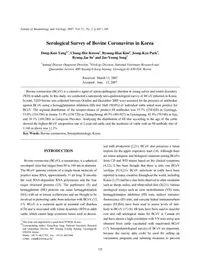
2007 Serological Survey of Bovine Coronavirus in Korea PDF
Preview 2007 Serological Survey of Bovine Coronavirus in Korea
Journal of Bacteriology and Virology 2007. Vol. 37, No. 2 p.105 – 109 Serological Survey of Bovine Coronavirus in Korea Dong-Kun Yang1,*, Chang-Hee Kweon1, Byoung-Han Kim2, Jeong-Kyu Park1, Byung-Jae So1 and Jae-Young Song2 1Animal Disease Diagnosis Division, 2Virology Division, National Veterinary Research and Quarantine Service, 480 Anyang 6-dong Anyang, Gyeonggi-do 430-824, Korea Received : March 13, 2007 Accepted : June 12, 2007 Bovine coronavirus (BCoV) is a causative agent of entero-pathogenic diarrhea in young calves and winter dysentery (WD) in adult cattle. In this study, we conducted a nationwide sero-epidemiological survey of BCoV infection in Korea. In total, 3,029 bovine sera collected between October and December 2005 were screened for the presence of antibodies against BCoV using a hemagglutination inhibition (HI) test. Half (50.0%) of individual cattle tested were positive for BCoV. The regional distribution of the seroprevalence of positive HI antibodies was 55.7% (234/420) in Gyeonggi, 53.0% (316/596) in Jeonra, 51.9% (374/720) in Chungcheong, 48.5% (401/827) in Gyeongsang, 43.9% (79/180) in Jeju, and 38.1% (109/286) in Gangwon Province. Analyzing the distribution of HI titer according to the age of the cattle showed the highest BCoV seropositive rate in 5-year-old cattle, and the incidence of cattle with an HI antibody titer of 1:160 or above was 12.1%. Key Words: Bovine coronavirus, Seroepidemiology, Korea INTRODUCTION Bovine coronavirus (BCoV), a coronavirus, is a spherical, enveloped virus that ranges from 80 to 160 nm in diameter. The BCoV genome consists of a single linear molecule of positive sense RNA, approximately 31 kb long. It encodes the viral RNA-dependent RNA polymerase and the four major structural proteins (15). The peplomeric (S) and hemagglutinin (HE) proteins can cause hemagglutination (HA) with rat or mouse erythrocytes and are thought to be involved in protecting cattle from infection with BCoV (13, 17). BCoV is a common agent in neonatal calf diarrhea (CD) and is associated with winter dysentery (WD) in adult cattle, which causes large economic losses such as decrea- sed milk production (2,21). BCoV also possesses a tissue tropism for the upper respiratory tract (14). Although there are minor antigenic and biological variations among BCoVs from CD and WD strains based on the clinical symptoms (4,12), it has been thought that there is only one BCoV serotype (9,14,21). BCoV infections in cattle have been reported in many countries throughout the world, including Korea (3,13) and have also been observed in other ruminants such as sheep, mules, and white-tailed deer (20,21). Various serological assays such as virus neutralization (VN) tests, hemagglutination inhibition (HI) tests, indirect immuno- fluorescence (IF) tests, and enzyme linked immunosorbent assays (ELISA) have been used to assess levels of anti- body to BCoV (17,18). HI tests have been used to describe cow and calf serological status for BCoV in Canada (6) and have shown a high correlation with VN tests using sera obtained from cattle vaccinated with inactivated BCoV (17). Seroepidemiological surveys of BCoV are important, because the survey data could be used for setting up vaccination programs and initiating measures to prevent *This work was supported by a grant from NVRQS, Korea. **Corresponding author: Dong-Kun Yang. National Veterinary Research and Quarantine Service, 480 Anyang 6-dong Anyang, Gyeonggi-do 430-824, Korea. Phone: +82-31-4671792, Fax: +82-31-4671868, e-mail:
